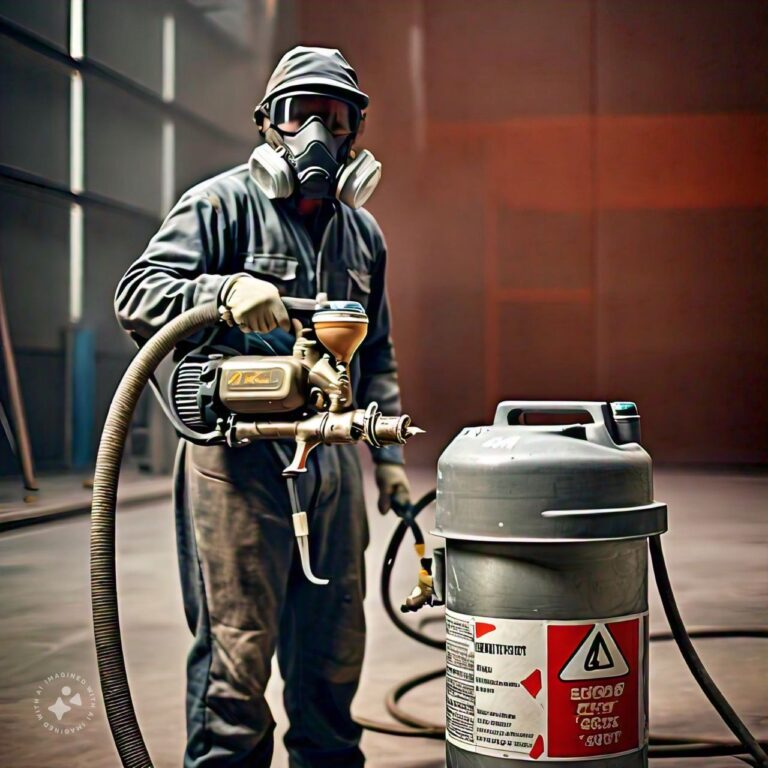Understanding Airless Sprayers
Airless sprayers are powerful tools used for painting large surfaces quickly and efficiently. Unlike traditional paint sprayers that rely on air to atomize the paint, airless sprayers use high pressure to force the paint through a small nozzle, creating a fine mist that adheres evenly to surfaces. These devices are favored for their ability to cover large areas with minimal overspray and consistent finish. They are commonly used for applying latex paint, which is water-based and widely used in both residential and commercial projects. Airless sprayers are versatile and can handle a variety of coatings, including primers, stains, and lacquers. However, understanding the specific capabilities and limitations of your airless sprayer is crucial to ensure optimal performance and safety, especially when considering different types of fluids.
Gasoline vs Latex
When comparing gasoline to latex in the context of airless sprayers, it’s essential to understand their fundamental differences. Latex paint, being water-based, is designed to flow easily through airless sprayers and dry quickly with minimal fumes. It’s suitable for indoor and outdoor applications and can be cleaned up with soap and water. On the other hand, gasoline is a flammable petroleum-based liquid, not intended for use with airless paint sprayers. Running gasoline through an airless sprayer can pose significant safety risks, including fire hazards and damage to the sprayer’s internal components. The chemical properties of gasoline are incompatible with the materials used in airless sprayers, which are designed to handle water-based or oil-based paints. Thus, it’s crucial to use airless sprayers only with fluids they are designed to handle, primarily to ensure safety and equipment longevity.
Airless Sprayer Safety
Safety is paramount when operating any airless sprayer, especially considering the high pressures involved. Before using an airless sprayer, always read and follow the manufacturer’s instructions and safety guidelines. Ensure that you wear appropriate personal protective equipment (PPE) such as gloves, goggles, and respiratory protection to safeguard against paint fumes and high-pressure spray. Never attempt to use flammable liquids like gasoline in your airless sprayer. Doing so can result in serious injury or damage due to the flammability of gasoline and the high pressure at which sprayers operate. Regularly inspect the sprayer for any signs of wear or damage, particularly in the hose and nozzle areas, to prevent malfunctions. Maintain a clean and organized work area to avoid accidents and ensure that all electrical components are properly insulated and grounded. By adhering to these safety precautions, you can operate your airless sprayer efficiently and safely.
Chemical Compatibility
Chemical compatibility is a critical consideration when using any spraying equipment. Airless sprayers are specifically designed to handle certain types of fluids, predominantly water-based and oil-based paints. The materials used in the construction of the sprayer, such as seals, hoses, and nozzles, are selected based on their resistance to these chemicals. Introducing a highly flammable and chemically reactive substance like gasoline can compromise the integrity of these materials, leading to potential leaks, damage, or catastrophic failure. It’s essential to consult the sprayer’s user manual or contact the manufacturer to confirm what substances are safe to use. For example, while latex paint is compatible due to its water-based nature, gasoline is not. An important takeaway from the discussion on chemical compatibility is that not all fluids can be safely used in airless sprayers, and adhering to manufacturer recommendations is vital.
Sprayer Mechanisms
The mechanisms of an airless sprayer are designed to handle specific types of paint, such as latex, by creating high pressure to atomize the paint. The main components include a pump, a hose, and a spray gun with a nozzle. The pump generates high pressure that pushes the paint through the hose and out of the nozzle, where it is finely atomized into a spray. This process is efficient for applying even coats of paint quickly. However, the sprayer’s mechanisms are built with certain materials in mind. Running gasoline through an airless sprayer is not advisable because the volatile nature of gasoline can cause excessive wear or damage to the seals, hoses, and pump. Furthermore, the flammability of gasoline poses a significant risk when subjected to high pressures. It’s crucial to understand that each component of the sprayer is engineered for specific fluids, and using incompatible substances can lead to dangerous outcomes.
Material Handling Guidelines
Proper material handling is essential for the safe and effective use of airless sprayers. When using an airless sprayer, always ensure that you are handling the materials it is designed for, such as latex paint or other compatible coatings. Store these materials in a cool, dry place away from direct sunlight and sources of ignition. Before loading the sprayer, mix the paint thoroughly to ensure a consistent application. Clean the sprayer immediately after use to prevent the paint from drying inside the system, which can cause blockages or damage. Never attempt to run gasoline through an airless sprayer latex, as it can lead to hazardous situations. Gasoline is highly flammable and can react violently when subjected to high pressure, posing risks to both the operator and the equipment. Following these guidelines ensures the longevity of your sprayer and the safety of your work environment.
Proper Cleaning Procedures
Proper cleaning procedures are essential to maintain the functionality and longevity of your airless sprayer. After each use, begin by relieving the pressure in the system according to the manufacturer’s instructions. Disassemble the sprayer parts such as the nozzle, hose, and gun. For latex paint, rinse these components thoroughly with water or a recommended cleaning solution. Use a brush to remove any remaining paint residues from the nozzle and filters. It’s crucial to clean the sprayer immediately after use to prevent the paint from drying and clogging the system. Avoid using harsh chemicals that could damage the internal components. Instead, stick to the recommended cleaning agents specified in the user manual. Regular cleaning not only ensures that your sprayer operates smoothly but also prolongs its life. It’s an essential routine that every user should diligently follow, especially after using latex paints.
Safety Precautions
Ensuring safety when using an airless sprayer cannot be overstated, particularly when addressing the question, “can you run gasoline through an airless sprayer latex?” The answer is a resounding no, due to the high risk of fire and explosion. Always wear appropriate personal protective equipment (PPE) such as gloves, safety glasses, and a respirator to protect yourself from paint fumes and high-pressure spray. Make sure the work area is well-ventilated to disperse any harmful vapors. Never aim the sprayer at yourself or others to avoid accidental injury. Be cautious with electrical components and ensure they are properly insulated and grounded. Keep a fire extinguisher nearby, especially if you are working with oil-based paints or in enclosed spaces. Properly dispose of cleaning solvents and paint residues according to local regulations to avoid environmental hazards. By adhering to these safety precautions, you can significantly reduce the risk of accidents and ensure a safe working environment.
Sprayer Maintenance Tips
Regular maintenance of your airless sprayer is vital for its performance and durability. Start by routinely inspecting the sprayer for any signs of wear or damage, particularly in the hose, nozzle, and pump areas. Replace worn-out parts promptly to prevent malfunctions. Lubricate the pump regularly as recommended by the manufacturer to keep it running smoothly. Store the sprayer in a clean, dry place to avoid rust and corrosion. For those questioning, “can you run gasoline through an airless sprayer latex?” Remember that using inappropriate materials like gasoline can cause severe damage and void the warranty. It’s crucial to use the sprayer exclusively for its intended purpose – primarily for water-based and oil-based paints. Implementing these maintenance tips ensures that your sprayer remains in top condition, ready for use whenever needed. Regular upkeep not only enhances the lifespan of the sprayer but also ensures consistent, high-quality performance.
Expert Opinions
Consulting expert opinions can provide valuable insights and reinforce the best practices for using and maintaining airless sprayers. Most experts strongly advise against using gasoline or any highly flammable liquids in airless sprayers, emphasizing the significant safety risks involved. They recommend using the sprayer for its intended purposes – primarily applying latex and oil-based paints. Experts also highlight the importance of following the manufacturer’s instructions and guidelines for optimal performance and safety. Regular cleaning and maintenance are frequently cited as key factors in prolonging the life of the sprayer. Additionally, experts often suggest investing in high-quality equipment and replacement parts to ensure reliability and efficiency. By adhering to these expert recommendations, you can enhance your spraying experience and achieve professional-quality results. Remember, when in doubt, always seek advice from knowledgeable professionals to avoid costly mistakes and ensure safe operation.
Alternatives to Gasoline
When considering the question, “can you run gasoline through an airless sprayer latex?”, it’s vital to explore safer alternatives to using gasoline. For cleaning purposes, instead of gasoline, use water or a water-based cleaning solution for latex paints, and mineral spirits or paint thinners for oil-based paints. These alternatives are less hazardous and designed to work effectively with the materials used in airless sprayers. If you need to spray a solvent-based product, ensure it’s compatible with your sprayer and approved by the manufacturer. There are specialized sprayers available for applying more volatile substances safely. Investing in the correct equipment and using appropriate materials ensures both safety and efficiency. By choosing safer alternatives, you can avoid the risks associated with using gasoline and maintain a safer working environment.
Common Mistakes
Using an airless sprayer requires attention to detail to avoid common mistakes that can lead to poor results or equipment damage. One prevalent error is using incompatible materials, such as trying to run gasoline through an airless sprayer latex, which is hazardous and can damage the sprayer. Another mistake is neglecting regular cleaning and maintenance, leading to clogged nozzles and reduced performance. Failing to wear proper PPE can result in exposure to harmful chemicals and high-pressure spray injuries. Using the wrong spray tip or not adjusting the pressure correctly can cause uneven coverage and wastage of paint. Not following the manufacturer’s guidelines for operation and maintenance can void warranties and lead to costly repairs. By being aware of these common mistakes and taking preventive measures, you can ensure a smooth and efficient spraying experience, achieving the best possible results safely and effectively.
FAQ’s
Can you run gasoline through an airless sprayer with latex?
No, running gasoline through an airless sprayer with latex is dangerous and can cause fires or damage the equipment. Stick to water-based or oil-based paints.
What happens if you use gasoline in an airless sprayer?
Using gasoline can lead to fire hazards, damage the sprayer, and void warranties. It’s not designed for flammable liquids.
Are there safe alternatives to gasoline for airless sprayers?
Yes, use water or recommended paint thinners for latex paints. For oil-based paints, use mineral spirits or paint thinners.
What safety precautions should I take with an airless sprayer?
Wear protective gear, work in a well-ventilated area, and avoid using flammable liquids like gasoline.
Can I use latex paint without thinning it for an airless sprayer?
Yes, most latex paints are formulated for use without thinning. Check the manufacturer’s guidelines.

